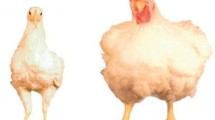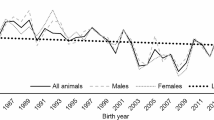Summary
Data collected on a privately owned ranch located in the Machakos District of Kenya at approximately 2° latitude south of the equator at an elevation varying from 1,675 to 2,000 m were analysed on five breed groups of cows: (1) purebred Boran, (2) 1/2 Charolais-1/2 Boran (1/2 C-1/2 B), (3) 3/4 Boran-1/4 Charolais (3/4 B-1/4 C), (4) 1/2 Ayrshire-1/2 Boran (1/2 A-1/2 B) and (5) 1/2 Santa Gertrudis-1/2 Boran (1/2 SG-1/2 B). The maternal traits evaluated included age at first calving, calving interval, calf weight at weaning and cow productivity index (calf weight weaned annually per cow calving). Mean cow productivity index for all cows was 192 kg; for purebred Boran, 174 kg; for 1/2 C-1/2 B, 200 kg; for 3/4 B-1/4 C, 191 kg; for 1/2 A-1/2 B, 210 kg; and for 1/2 SG-1/2 B, 185 kg. Cow breed groups 1/2 C-1/2 B, 3/4 B-1/4 C, 1/2 A-1/2 B and 1/2 SG-1/2 B exceeded (P<0.01) purebred Boran by 14.9, 9.8, 20.7 and 6.3%, respectively, in cow productivity index.
Résumé
Les données recueillies sur un ranch privé situé dans le district de Machakos au Kenya approximativement sous 2° de latitude Sud et à une altitude de 1675 à 2000 m ont été analysées pour cinq groupes de vaches appartenant aux races suivantes (1) Boran pur, (2) 1/2 Charolais-1/2 Boran (1/2 C-1/2 B), (3) 3/4 Boran-1/4 Charolais (3/4 B-1/4 C), (4) 1/2 Ayrshire-1/2 Boran (1/2 A-1/2 B) and (5) 1/2 Santa Gertrudis-1/2 Boran (1/2 SG-1/2 B). Les caractères maternels estimés comprenaient l'âge au premier vêlage, l'intervalle entre vêlages le poids du veau au sevrage et l'index de productivité des vaches (poids du veau sevré annuellement par vache mettant bas). L'index de productivité moyen des vaches pour toutes les vaches était de 192 kg. Pour le Boran pur, 174 kg; pour le 1/2 C-1/2 B, 200 kg; pour le 3/4 B-1/4 C, 191 kg; pour le 1/2 A-1/2 B, 210 kg; et pour le 1/2 SG-1/2 B, 185 kg. Les groupes de vaches suivants (1/2 C-1/2 B), (3/4 B-1/4 C), (1/2 A-1/2 B) et (1/2 SG-1/2 B) dépassaient les Boran pures de 14,9 p.100, 9,8 p. 100, 20,7 p. 100 et 6,3 p. 100 respectivement pour l'index de productivité avec une significativité de plus de 1 p. 100.
Resumen
Se analizaron los datos colectados en una finca privada localizada en el Distrito de Machakos de Kenia, 2° latitud sur del ecuador, a una elevación comprendida entre los 1.675 y 2.000 metros, de cinco grupos de vacas puras Boran, 1/2 Charolais-1/2 Boran (1/2 C-1/2 B), 3/4 Boran-1/4 Charolais (3/4 B-1/4 CH), 1/2 Ayrshire-1/2 Boran (1/2 A-1/2 B) y 1/2 Santa Gertrudis-1/2 Boran (1/2 SG-1/2 B). Los rasgos maternos evaluados incluyeron edad al primer parto, intervalo de partos, peso de la cría al destete y el índice de productividad de las vacas(peso de las crías destetadas anualmente por parto). La media del índice de productividad para todas las vacas fue de 192 kilogramos; para la raza pura Boran, 174 kg; para 1/2 C-1/2 B 200; para 3/4 B-1/4 C, 191 kg; para 1/2 A-1/2 B, 210 kg y 1/2 SG-1/2 B, 185 kg. Los grupos (1/2 C-1/2 B), (3/4 B-1/4 C), (1/2 A-1/2 B) y (1/2 SG-1/2 B) excedieron (P<0.01) al grupo Boran puro en índice de productividad por 14.9%, 9.8%, 20.7% y 6.3%, respectivamente.
Similar content being viewed by others
References
Cartwright, T. C., Ellis, G. F., Jr, Kruse, W. E. & Crouch, E. K. (1964). Texas Agricultural Experimental Station. Monograph 1.
Cundiff, L. V., Gregory, K. E. & Koch, R. M. (1974).Journal of Animal Science,38, 711–727.
Cundiff, L. V., Gregory, K. E., Schwulst, F. J. & Koch, R. M. (1974).Journal of Animal Science,38, 728–745.
Cundiff, L. V., Gregory, K. E. & Koch, R. M. (1982). Selection for increased surivival from birth to weaning. Proceedings 2nd World Congress on Genetics Applied to Livestock Production, V, pp. 310–337.
Gregory, K. E. & Cundiff, L. V. (1980).Journal of Animal Science,51, 1224–1242.
Gregory, K. E., Trail, J. C. M., Marples, H. J. S. & Kakonge, J. (1984a).Journal of Animal Science (submitted).
Gregory, K. E., Trail, J. C. M., Marples, H. J. S. & Kakonge, J. (1984b).Journal of Animal Science (submitted).
Koger, M., Peacock, F. M., Kird, W. G. & Crockett, J. R. (1975).Journal of Animal Science,40, 826–833.
Harvey, W. R. (1977). User's guide for LSML 76 — Mixed model least-squares and maximum likelihood computer program. Ohio State University, Columbus.
Trail, J. C. M., Sacker, G. D. & Fisher, I. L. (1971).Animal Production,13, 127–141.
Author information
Authors and Affiliations
Rights and permissions
About this article
Cite this article
Gregory, K.E., Trail, J.C.M., Sandford, J. et al. Crossbreeding cattle in beef production programmes in Kenya. Trop Anim Health Prod 16, 181–186 (1984). https://doi.org/10.1007/BF02252788
Accepted:
Issue Date:
DOI: https://doi.org/10.1007/BF02252788




